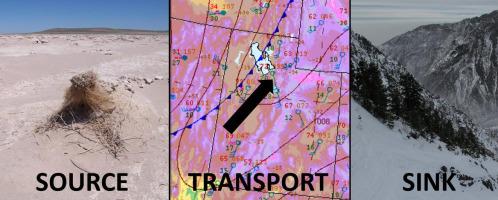Aeolian Research ( IF 3.1 ) Pub Date : 2020-06-24 , DOI: 10.1016/j.aeolia.2019.06.002 Kathleen Nicoll , Maura Hahnenberger , Harland L. Goldstein

|
On 14–15 April 2015, an intense intermountain cyclone in the western USA caused high winds and a dust storm that degraded air quality in the eastern Great Basin, and deposited dust-on-snow (DOS) in the Wasatch Range near Salt Lake City, Utah. We analyzed the storm and documented its “source-to-sink” development to relate the frontal passage with dust mobilization, air quality changes, and dust deposition on montane snowpack near Alta, Utah. This case study is first to track a dust storm and measure the elemental composition and radiative properties of the resulting DOS as a single specific event layer in Wasatch montane snowpack; prior studies have assessed seasonally aggregated DOS deposits. Dust plumes on MODIS imagery indicate mobilization from known regional “hotspots” for aeolian activity, including clay- and silt-rich alluvium, modern playas, and disturbed areas within the Pleistocene Paleolake Bonneville Basin. This 2015 single event dust layer was 1–3 cm thick with a median dust size of 10.81–12.55 µm; its measured radiative properties are similar to aggregated dusts previously assessed in Wasatch snowpack. Dust from the 2015 DOS event is enriched in the elements As, Cd, Cu, and Mo by a 10× factor relative to average elemental concentrations in the upper continental crust; its heavy metals (Cu, Pb, As, Cd, Mo, Zn) are probably derived from regional mine operations. Tracking elemental fluxes from source-to-sink is important for resolving environmental impacts, and informing future analysis of single storm dust loading, ecosystem impacts, and quantity and quality of meltwater-fed drinking water.
中文翻译:

从源头到接收者的“风中之尘”:2015年4月14日至15日在犹他州的风暴分析
2015年4月14日至15日,美国西部发生强烈的山间气旋,造成大风和沙尘暴,使大盆地东部的空气质量下降,并在盐湖城附近的Wasatch山脉沉积了雪上粉尘(DOS) ,犹他州。我们分析了这场风暴,并记录了其“从源头到汇点”的发展过程,以将额叶通道与扬尘动员,空气质量变化以及犹他州阿尔塔附近的山地积雪上的扬尘联系起来。本案例研究首先追踪沙尘暴并测量Wasatch山地积雪中单个特定事件层的最终DOS的元素组成和辐射特性;先前的研究评估了季节性聚集的DOS沉积物。MODIS影像上的尘埃羽表明来自风沙活动的已知区域“热点”的动员,包括富含粘土和淤泥的冲积层,和更新世古邦纳维尔盆地内的受干扰地区。2015年的单事件尘埃层厚1–3 cm,中值尘埃尺寸为10.81–12.55 µm;其测量的辐射特性类似于先前在Wasatch积雪中评估的聚集尘埃。相对于上部大陆壳中平均元素浓度,2015年DOS事件产生的粉尘中的As,Cd,Cu和Mo元素含量增加了10倍。其重金属(铜,铅,砷,镉,钼,锌)可能来自区域性矿山。跟踪从源到汇的元素通量对于解决环境影响,以及为将来对单次暴风尘负荷,生态系统影响以及由融水喂养的饮用水的数量和质量进行分析提供重要信息。2015年的单事件尘埃层厚度为1–3 cm,中值尘埃尺寸为10.81–12.55 µm;其测量的辐射特性类似于先前在Wasatch积雪中评估的聚集尘埃。相对于上部大陆壳中平均元素浓度,2015年DOS事件产生的粉尘中的As,Cd,Cu和Mo元素含量增加了10倍。其重金属(铜,铅,砷,镉,钼,锌)可能来自区域性矿山。跟踪从源到汇的元素通量对于解决环境影响,以及为将来对单次暴风尘负荷,生态系统影响以及由融水喂养的饮用水的数量和质量进行分析提供重要信息。2015年的单事件尘埃层厚度为1–3 cm,中值尘埃尺寸为10.81–12.55 µm;其测量的辐射特性类似于先前在Wasatch积雪中评估的聚集尘埃。相对于上部大陆壳中平均元素浓度,2015年DOS事件产生的粉尘中的As,Cd,Cu和Mo元素含量增加了10倍。其重金属(铜,铅,砷,镉,钼,锌)可能来自区域性矿山。跟踪从源到汇的元素通量对于解决环境影响,以及为将来对单次暴风尘负荷,生态系统影响以及由融水喂养的饮用水的数量和质量进行分析提供重要信息。其测量的辐射特性类似于先前在Wasatch积雪中评估的聚集尘埃。相对于上部大陆壳中平均元素浓度,2015年DOS事件产生的粉尘中的As,Cd,Cu和Mo元素含量增加了10倍。其重金属(铜,铅,砷,镉,钼,锌)可能来自区域性矿山。跟踪从源到汇的元素通量对于解决环境影响,以及为将来对单次暴风尘负荷,生态系统影响以及由融水喂养的饮用水的数量和质量进行分析提供重要信息。其测量的辐射特性类似于先前在Wasatch积雪中评估的聚集尘埃。相对于上部大陆壳中平均元素浓度,2015年DOS事件产生的粉尘中的As,Cd,Cu和Mo元素含量增加了10倍。其重金属(铜,铅,砷,镉,钼,锌)可能来自区域性矿山。跟踪从源到汇的元素通量对于解决环境影响,以及为将来对单次暴风尘负荷,生态系统影响以及由融水喂养的饮用水的数量和质量进行分析提供重要信息。Zn)可能来自区域性矿山运营。跟踪从源到汇的元素通量对于解决环境影响,以及为将来对单次暴风尘负荷,生态系统影响以及由融水喂养的饮用水的数量和质量进行分析提供重要信息。Zn)可能来自区域性矿山运营。跟踪从源到汇的元素通量对于解决环境影响,以及为将来对单次暴风尘负荷,生态系统影响以及由融水喂养的饮用水的数量和质量进行分析提供重要信息。











































 京公网安备 11010802027423号
京公网安备 11010802027423号